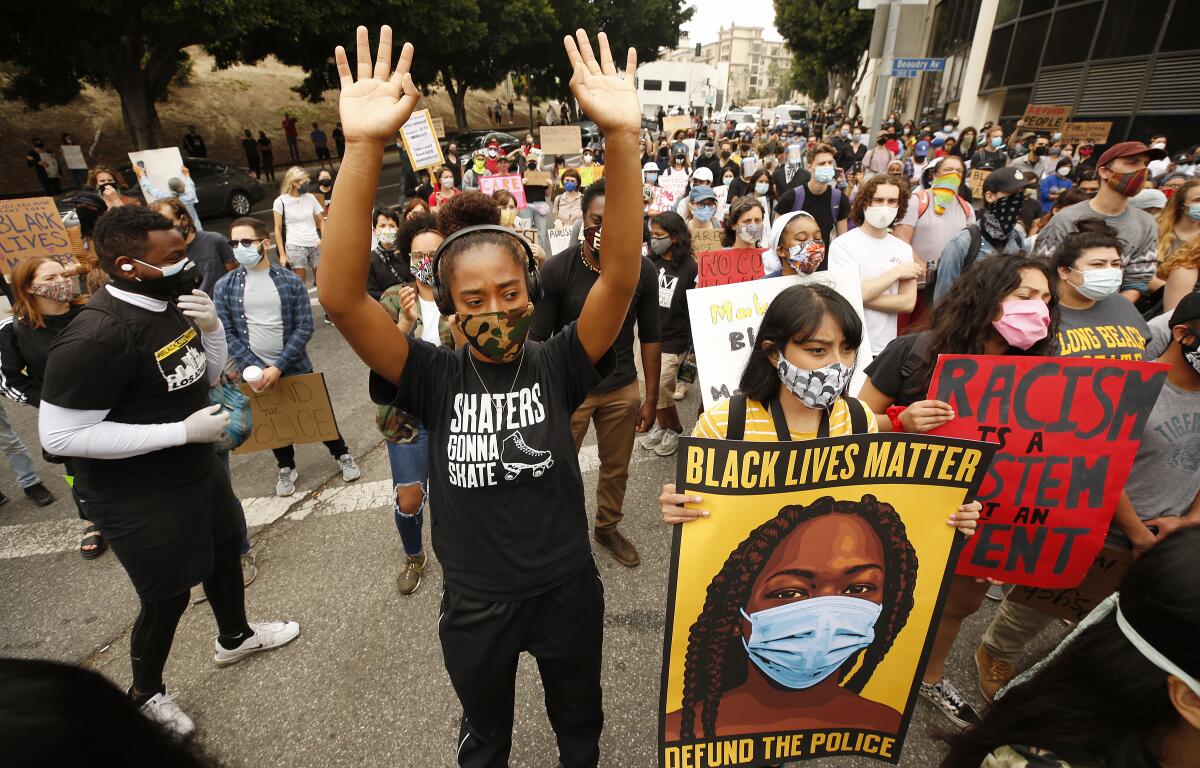Who tells the story matters. And that’s why you need Black journalists at every level in newsrooms

- Share via
Black journalists in Los Angeles are fed up. Again.
The nation is in the throes of a pandemic, soaring unemployment and a racial chasm that is cleaving its way across the country. It’s hard to fathom that Black journalists continue to have to battle for inclusion and input in America’s newsrooms, even as Black Americans are disproportionately affected by COVID-related disease, debt and discrimination.
It’s often been said that journalism is history on the run. History is being made daily, and it is the job of journalists to provide eyewitness accounts. But the vantage point of those accounts matters, and we need to ask ourselves: Whose narrative are we getting? Other points of view are diminished when only one voice is heard.
For decades, Black people have been invited inside the halls of journalism, but not too many at a time. Even fewer advance to the levels where decisions are made about news coverage, reporter assignments, promotion and pay. Getting jobs in the Los Angeles news market is challenging for us, in part because the Black population here is smaller and major markets are difficult to penetrate, but more so because here, the culture and direction of news coverage have too often minimized or excluded our input.
It’s time for that to end once and for all.
The anger today is not limited to the issue of jobs and pay. It’s about full participation in the journalistic process to ensure that other views are included in telling the stories of Los Angeles and America. What’s galling is that this isn’t the first time we’ve had to explain all this and demand our seats at the table. Part of today’s movement for change in L.A. newsrooms began in Los Angeles 40 years ago. I was there.
The Black Journalists Assn. of Southern California first met in April 1980 at a secret after-work gathering of some of L.A.’s Black journalists. Reporters from the Los Angeles Times, Herald Examiner, Associated Press, Long Beach Press-Telegram, KFWB, KNX, KJLH-FM, KCBS-TV, KNBC-TV, the Valley News (which later became the L.A. Daily News), the Los Angeles Sentinel and more met to address the inequities of L.A.’s newsrooms: Unequal pay. Few or no advancement opportunities. Isolation. Biased, inaccurate coverage of the Black community, or, worse, no coverage at all.
Sound familiar?
Then, as now, the racial atmosphere in the city was unsettling. It was an era when Los Angeles had a police chief — Daryl Gates — who advanced the absurd theory that Blacks were dying from police-applied chokeholds because our necks were not the same as those of “normal” people.
Not long after the birth of the BJASC came the publication of a notorious 1981 front-page story in the Los Angeles Times that underscored our reasons to organize. It was headlined “Marauders from the Inner City Prey on L.A.’s Suburbs” and its content was so alarmist, so lacking context, so dependent on racial stereotypes that it drew national condemnation. A few years earlier, The Times had ignored for months the LAPD’s deadly shooting of a Black woman, Eula Love, in front of her children after a dispute over an unpaid gas bill. The Times had to play catch-up followed by issuing mea culpas and promising to do better. The “mauraders” story proved that the promises didn’t stick.
Over the next decade, news outlets began to respond under the watchful eyes of organized Black journalists locally and nationally. To its credit, The Times hired some talented Black journalists and adopted a change in its approach to covering communities of color. Early results were positive as the paper did a better job than most in exploring the causes and context of the riots that erupted in the aftermath of the Rodney King verdict and the caught-on-camera killing of 15-year-old Latasha Harlins by a Korean store owner. The Times even created now-defunct weekly news sections focused on South and East L.A. Similar actions by other local news outlets seemed to signal a new and inclusive editorial direction. But the progress didn’t last.
Black journalists and white journalists are equally capable of covering national and international issues of importance to the nation, but they are not always equally capable of covering issues of importance to the Black community. That’s because Black reporters, more often than not, bring unique knowledge of and familiarity with Black life and culture. Even more important, as journalists, they have the trust of those underserved by the white-dominated press, and the ability to bridge the cultural divide at the core of today’s national protest movements.
Sadly, Black journalists at the L.A. Times and other outlets are once again struggling with management for redress of the same grievances we raised 40 years ago, against the same backdrop of police-inflicted racial violence and a city profoundly unnerved by it. Their small number and absence from key newsroom decision-making positions make their jobs difficult and frustrating, as came out in last week’s four-hour-long internal Zoom meeting where concerns were voiced to top management.
So, here we are again, with news organizations trying to drive in a rainstorm with broken wipers, trying to cover today’s important stories about being Black in America with scant input from the very folks who experience it. Those of us who fought the same battles decades ago and support these Black journalists today hope the new awareness of “Black Lives” sweeping the nation finds its way inside our newsrooms as well.
The mission of accurate and inclusive journalism is at stake.
Tony Cox, a longtime broadcast journalist in Los Angeles and journalism professor at Cal State Los Angeles, was founding president of the Black Journalists Assn. of Southern California.
More to Read
A cure for the common opinion
Get thought-provoking perspectives with our weekly newsletter.
You may occasionally receive promotional content from the Los Angeles Times.









